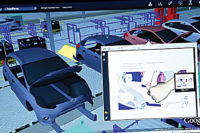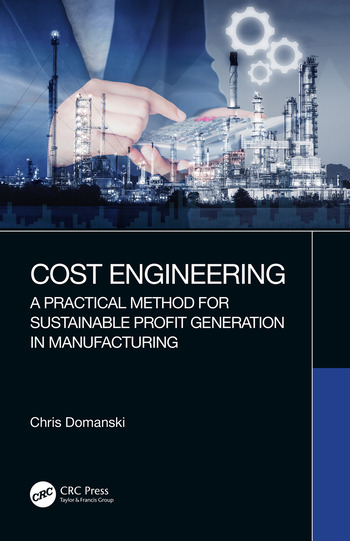Cost modeling is the practice of understanding the cost structure of the products purchased or manufactured for the purpose of optimizing a design or supply chain. Whirlpool Corporation defines cost modeling as:
A process that mimics the costs of the production source. It identifies the cost drivers and serves as a basis for new product calculations and competitive comparisons.
The cost modeling process is focused on supporting three business areas: target costing, procurement, and competitive analysis.
Target costing is a process to manage and optimize the value delivered to the customer. The target costing process relies on quick and accurate cost estimates to be able to optimize the new product design. The cost modeling process identifies cost drivers and facilitates informed development decisions.
Procurement uses cost models as a cost verification and negotiation tool. The cost model gives them a breakdown of the costs to understand the competitiveness of the supply base and improve negotiations. Competitive analysis is a process that uses cost modeling to accurately and quickly estimate the costs of competitive assemblies and make decisions for new products and existing product improvements.
The cost model is developed with cost elements and variables. (See Fig. 1.) Cost elements are the major areas of cost such as material, labor, and overhead. Cost variables are the components of the cost elements such as the material type, scrap, and transportation cost. The cost variables for any product will need to be determined depending on the manufacturing method, supply chain, and industrial norms.
There are three types of cost models, each with increasing levels of maturity: the parametric model, the industry model, and the supplier specific model. Some commodities can be adequately modeled using the least mature model (parametric), while other commodities require the use of the most mature model (supplier specific). (See Fig. 2.)
Parametric Models
The simplest way to estimate the cost of a part is to develop parametric models. Parametric models are cost relationships built off cost-driven parameters. The length of a bolt or wire or the number of outputs on a water valve are some cost-driven attributes or parameters. One common practice is to weigh a plastic part and calculate the material cost and then double the calculated value for a final cost. That is represented in the following equation.Weight * Material Cost * 2
Or
2 lbs of ABS * $0.50 / lbs * 2 = $2.00
This method might be acceptable for a rough estimation and might even accurately represent the price for the common plastic part in some industries, but it does not work for high-volume manufacturing. The generalized model simply does not accurately represent the supply base realities.
We might determine from a study of all the ABS parts that we purchase that the material cost is really 60 percent of the final cost. This would entail weighing the parts and calculating the material cost either with a market rate or an internal material rate. This is a more accurate parametric cost model than the previous 50 percent figure.
Caution must be paid when using parametric models to not use them beyond the sample limits. An example of this is the cost of a motor as it relates to the horsepower output. (See Fig. 3.)
One might conclude that a 100 HP motor should cost $49.62. This seems like a reasonable conclusion, but the relationship might not be linear beyond the measured limits. An example of this non-linearity is the conclusion that a boy will grow to be 10 foot tall when he is 20 by sampling his height and age during the first 10 years of his life.
Parametric models can be used successfully for simple parts or anything that has a parameter with a strong correlation to the cost. Parametric models should not be used on items which are significant cost contributors such as the engine of an automobile.
Industry Cost Models
The next level of cost modeling is the industry model. This is a model that uses publicly available data to develop cost elements. This model identifies the general cost structure of a business or industrial sector. The data comes from financial publications, industrial publications, industry websites, government economic studies, or financial analysis.Industry studies are offered for sale, but they are geared toward the financial system and do not give a glimpse into the manufacturing costs as they are mainly hidden in the cost of goods sold. An example of a publically available study is the financial analysis offered by Dun and Bradstreet for an individual company or industry. These studies can be useful to identify the general financial structure and can be a starting point for your individual industry model, but more detail must be added.
An example of an industrial model that is generated with economic census data plus financial analysis might look like the example in Fig. 4.
The detail possible in the industrial model is limited only by time and resources. A model can be set up with generic industrial numbers and more details can be added by researching manufacturing methods and standard practices. The machine manufacturers can be contacted to add processing details. Rates can be determined using standard cost accounting practices.
The cost breakdown supplied by the industrial model can be used for calculations such as the potential leverage savings achieved by increasing the purchased amount with one supplier. A detailed cost breakdown can give a glimpse of the fixed/variable cost ratio to make this calculation. The potential for global savings can be estimated by factoring the labor down or up and adding logistics costs from the new region. This can become a very powerful planning and strategy tool.
Supply Chain Cost Models
The most time consuming cost model is the supply chain model due to the development time required and the time needed to properly implement. The supply chain model builds off of the industry and parametric models to help identify the cost drivers as a starting point, but breaks down the elements into as much detail as needed to quantify the significant cost variables. For example, the depreciation is a significant cost variable in the overhead cost element. A supply chain cost model will calculate the depreciation on each machine in the process.Obtaining information from suppliers can be challenging at times. Many are not able to share data due to corporate policies. One should come prepared for the discussions with preliminary calculations and industry metrics. When buyers come to the table with calculations that estimate the cost of suppliers’ processes, then the suppliers often are able to share.
The supply chain model utilizes knowledge of industry best practices to make sure the model represents the best manufacturing processes and not just the current supply base. Experts in the field should be used to keep track of trends and new technologies. The supply base needs to be challenged to keep up with these trends. Industry websites and publications help to keep up to date with changes. Cost modeling helps to assure cost competitiveness with any new trend.
An example of a detailed supply chain model would be one that estimates the cost of a plastic part by calculating the material, manufacturing, and corporate costs. The material is calculated by measuring the net weight and estimating the gross weight based on the manufacturing process. It is important to calculate the size of the injection molding press and the cycle time associated with each part. The press rate is determined to get a processing cost. The material and processing costs are then added to an operating cost and profit for a total. The material gross weight, press size, and rate can be calculated by using a number of different commercially available software packages. The press rates, operating costs, and profit need to be determined for each production source.
Due to the time requirements needed to develop supply based models, one will need to prioritize the work to the areas that will make the most financial sense or areas of unique components. An electric motor on a vacuum is most likely a common universal motor that has a price largely set by the market. A cost model on the electronic control or wiring harness will be more useful. One can set priority and modeling levels based on impact and uniqueness.
Modeling Software
The DFMA software from Boothroyd Dewhurst, Wakefield, R.I., can help in the development of these three model types. Items can have formulas added to the notes that relate the cost to given parameters. Industrial machine rates and factors are built into the default libraries for industrial calculations. The most powerful use of DFMA is for the supply based models. The software will calculate the optimized production method based on the component inputs. All of the system libraries can be customized with material and machine types and rates, operations, and assembly methods. The software output can be very accurate if the user is experienced in processing methods and the homework has been done to update the libraries to reflect actual costs.Conclusion
Cost modeling can help to identify the costs of a component or assembly. This knowledge can help identify costs early in the design process through the target costing process or any disciplined new product development process. The details and insight in the models help the buyers with negotiations. The data shared in the buying and negotiation process can be used to strengthen the cost models. The resultant cost models can be used to provide quick cost feedback for competitive product teardowns.Cost modeling is a very powerful tool in the product development process. The key is to get started with process and accounting experts that can grow in knowledge as the models grow in complexity.
For more information on Boothroyd Dewhurst DFMA software, visit:www.dfma.com
For more information on Whirlpool Corp., visit:www.whirlpoolcorp.com
(Editor’s note: This article is based on a presentation made by Jason Lynn at the 2009 International Forum on Design for Manufacture and Assembly held June 9-10, 2009, at Providence, R.I.)



